Matcha tea is bigger than ever—here's everything you need to know
The ultimate zen is just a couple of whisks away.
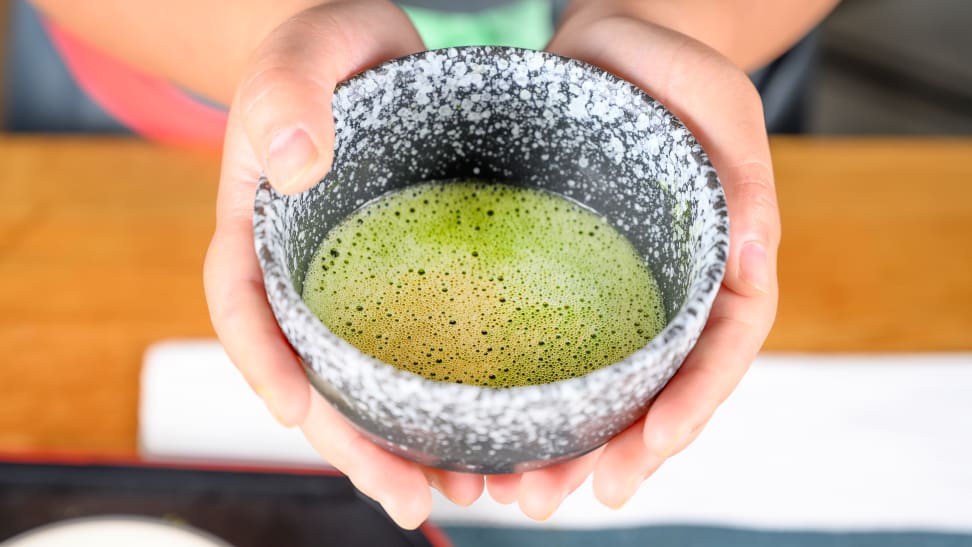 Credit:
Reviewed / Betsey Goldwasser
Credit:
Reviewed / Betsey Goldwasser
Products are chosen independently by our editors. Purchases made through our links may earn us a commission.
Whether prepared as tea or mixed into a Starbucks latte, the magical green tea powder known as matcha can provide both a boost of energy and some much-needed zen. In recent years, matcha has exploded in popularity outside of Japan and can now be found in everything from panda-shaped candy to calming face masks. It’s now considered an ultimate superfood for its ability to pack nutrients and antioxidant compounds in just a pinch.
The history of consuming powdered tea goes back to the Chinese Song dynasty, when people dried fresh tea leaves and shaped them into bricks for easy storage and transportation. When it came to drinking the tea, they whipped the pulverized tea leaves with hot water in a bowl.
While powdered tea became less popular in China as the abundance of fresh tea leaves increased, the Japanese, who were introduced to powdered tea by monk Eisai, never lost their taste or enthusiasm for the unique preparation.
As a passionate tea drinker who switches between Lapsang Souchong and Dragon Well, two distinct varietals of green tea, I always try to have matcha in stock—but it's not always easy to know what to buy. If you’re new to matcha and want to start reaping its benefits, here's our rundown of how to select, prepare, and enjoy it in all its forms.
What type of matcha should I buy?
You may have heard the buzz about the health benefits that matcha offers—studies have linked drinking matcha to stress reduction, mood improvement, and lower blood pressure. While I can't speak to these health benefits directly, I know that drinking matcha makes me feel relaxed, and that organic, higher-quality matcha tastes better and reduces my anxiety about accidentally consuming unwanted chemicals. For these reasons, I recommend treating it as a food item and buying the highest quality matcha possible.
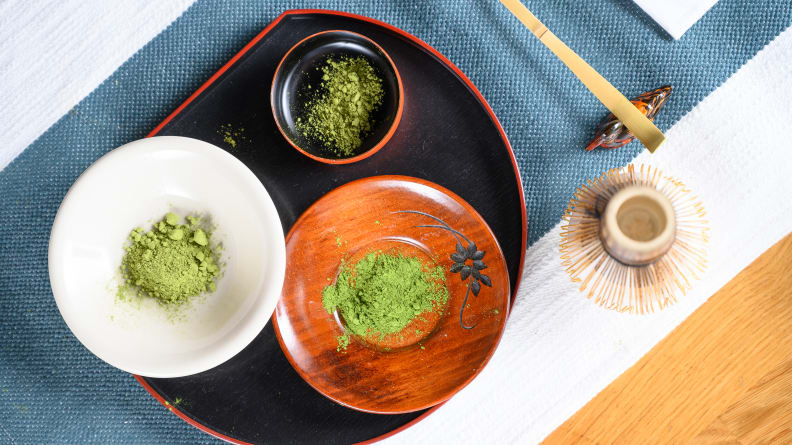
The high quality matcha powder has a bright, vibrant green color.
There are four common types of matcha powder: the cooking grade dakota, the cafe grade gotcha, the classic grade morning, and the ceremonial grade kama. The first two, pale green in appearances, are most popular for cakes, baked goods, ice cream, and smoothies. The cafe grade is also good for lattes.
The classic grade, made from early-harvested leaves, is good for sipping and it has a vegetal taste with a slightly bitter note at the end. The ceremonial grade—which contains the highest level of amino acids—features a distinctly vibrant green color, creamy texture, and irresistible aroma when whisked with hot water.
When I’m looking to bake and make smoothies, I usually use the culinary grade dakota sold in bags. If I’m feeling a bowl of warm, freshly-whisked matcha, I would go for either the classic or the ceremonial grade powder.
How to buy matcha the right way
Here are a few tips to keep in mind as you shop for matcha powder:
Always pay attention to the label—and buy from Japan.
China and South Korea export some “green tea powder,” but it's not true matcha, and the process is more industrial. This means the matcha is ground with machines, rather than the traditional stone mill method that’s still common in Japan. I wouldn’t buy from anywhere other than Japan.
Matcha is challenging to harvest, so pay for quality.
Having grown up in a tea country, I can attest that tea cultivation and preparation is time-consuming and labor-intensive. When it comes to matcha, the very fragile green tea leaves require gentle, shaded treatment for up to three weeks before harvest. Then, after being dried, the hand-picked leaves will enter the slow stone-grinding process, where one hour of work yields about 30 grams of tea powder. The workers can’t rush the process as, if the stone gets too warm, the tea will lose its flavor. This is why the price of the best matcha can be high. However, a good quality matcha powder, at an average $35 to $50 per ounce, is still affordable in comparison to some of the finest loose leaf tea in the world.
One tin will last you a while.
In Japan, the most common packaging of ceremonial grade matcha is in tin cans, ranging from 30 to 40 grams. If you’re using half of a teaspoon per serving, a tin of matcha powder will give you about 30 to 40 cups of tea, or usucha, which means light matcha in Japanese.
You might find a bigger selection of matcha online.
Some grocery stores such as Trader Joe’s and Whole Foods sell the culinary grade matcha for cooking and baking. However, brick-and-mortar retailers might not cover the wide range of matcha grades. Amazon, however, offers a good selection of high quality matcha powder, and I’m in love with some of its trusted sellers, such as Naoki.
Once you’ve purchased your matcha, it’s time to start preparing your tea. Here’s how to use the traditional Japanese method to make matcha right at home.
How to make traditional matcha tea (serves 1)
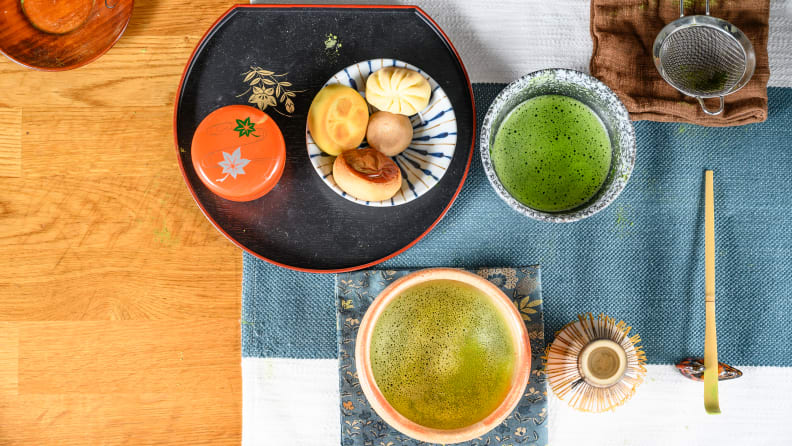
Here's how to prepare a bowl of matcha green tea.
Unlike coffee, matcha doesn’t produce any caffeine jitters. It makes you feel calm, relaxed, and clear-minded. To master the matcha whipping skill, you’ll need a little patience, and most importantly, the right beginner tools.
What you’ll need:
- A matcha set
- ½ tsp organic ceremonial grade matcha
- A set of measuring spoons
1. Prepare the hot water
Bring a pot of water to boil. Let it cool for about 10 minutes so the temperature drops to approximately 170°F. Put four tablespoons hot water into the teacup (chawan) to warm it. In the meantime, dip the tea whisk (chasen) into the teacup for a brief wash. Discard the water and wipe them dry with the tea towel from the set.
2. Prepare the tea
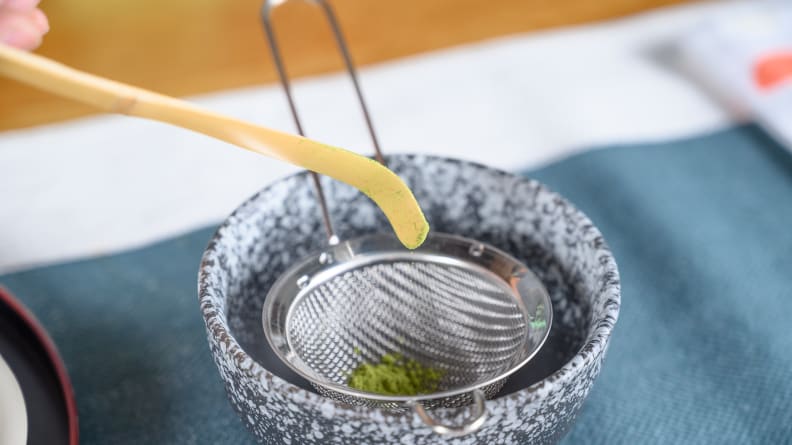
Sifting the powder makes the tea more smooth.
Use the bamboo tea spoon (chashaku) to scoop out two spoonfuls of matcha powder (it’s approximately equivalent to ½ tsp) and sift the powder into the teacup. Then, measure ⅜ cup of water in a bowl. Generally, the water to matcha powder ratio is 3 oz of water for every ½ tsp of powder.
4. Start whisking
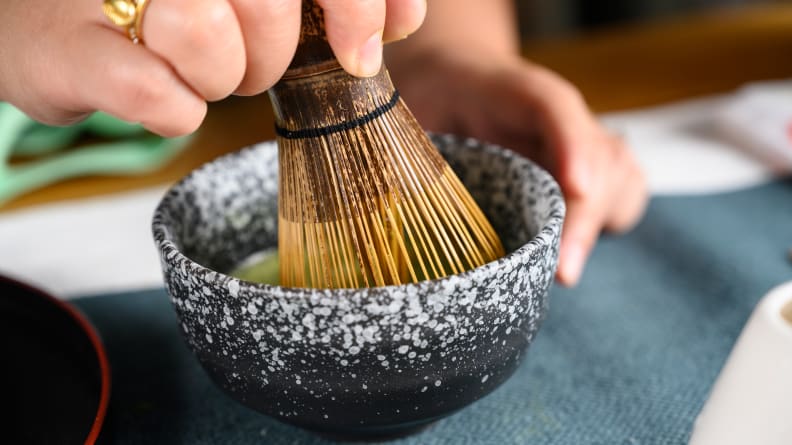
Whisking the tea in "w" or "m" shape.
First, add about two spoonfuls of water to the teacup and it react with the tea powder for about five seconds. Then add the rest of the water, and using the tea whisk, gently whisk the tea in W-shaped motion while gradually increasing the speed. Once you reach maximum speed, vigorously whisk the tea for about one minute until you see a layer of foam formed on the top.
5. Perfect the foam
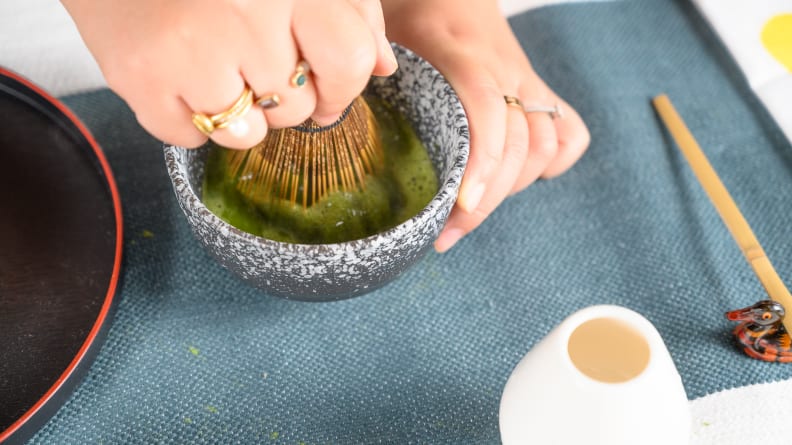
Slowly reduce the speed and try to make the bubbles as small as possible.
In a circular motion, gently whisk away large bubbles on the surface of the tea. This step is optional, but the ideal goal is to achieve consistently creamy foam instead of large bubbles on top for visual presentation. This foamy texture also creates a well-rounded mouthfeel when consuming.
6. Enjoy the tea!
The sugary confection wagashi is the traditional companion for matcha. Often flavored with cherry blossom and other traditional Japanese ingredients, wagashi is petite and delicate. The sweetness of this sugary treat strikes a perfect balance with the slightly bitter and earthy tea. You can either order them from Amazon, pick them up at an Asian grocery, or substitute them with a dessert of your choice.


